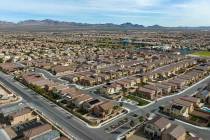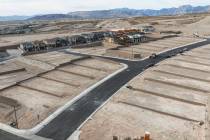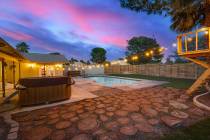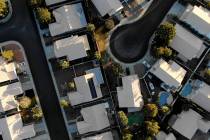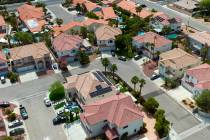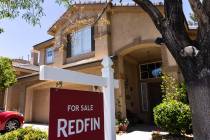Interest in new homes helps Pardee mark 60 years

When Pardee Homes built its first house in Las Vegas, nobody had heard of Elvis and you could talk to Howard Hughes without a Ouija board.
California-based Pardee debuted here in 1952, and it’s putting it mildly to say the company has seen some changes as it reaches its 60th year in the market.
Few differences were more dramatic than the epic housing bust that followed the biggest housing boom of the modern era. Southern Nevada sold a record 38,958 new homes in 2005, but didn’t even crack 4,000 closings in 2011.
The housing crisis bankrupted some builders and banished others from the market, but Pardee hunkered down, laying off more than 300 people, or 80 percent of its staff, to ride out the storm. As the company begins its seventh decade building locally, executives say the market shows hints of a turnaround, even as Southern Nevada’s new normal means we’re unlikely to ever see a return to peak sales.
EXCITEMENT RETURNS
Any market improvement requires a reversal of consumer sentiment. And that’s the biggest change Klif Andrews, Pardee’s Nevada president, said he sees in the local market these days. The company’s weekly sales traffic averaged 10 to 15 buyers a week per community at the economy’s 2010 nadir. Today, Pardee neighborhoods host twice that number, with an especially noticeable uptick in early 2012.
What’s more, buyers actually seem excited about buying. Gone is the recession’s grim, single-minded focus on price per square foot. Back is the buzz of consumers kicking tires.
"People are walking through and opening cabinets, playing with plumbing fixtures and walking all the way through models to look at everything," Andrews said. "They study appliances and ask about energy-saving features. I haven’t seen this in six years, where people are excited about the product, and not just asking about value."
Andrews credits the change to recession fatigue and improving consumer confidence, as the economy stabilizes and people who have jobs are more certain of keeping them.
Dennis Smith, president of Home Builders Research in Las Vegas, agreed with Andrews’ observations.
"The new-home industry has really been on its ear the past four or five years, having to compete with the prices of resales and distressed markets," Smith said. "But people are tired of looking at crap. Any house that sits empty for a period of time deteriorates very quickly. And there have been a huge number of changes in new homes, upgrades in energy-saving features and appliances and floor coverings and other materials. Builders can show off these new toys, and it makes sense that it would excite consumers, especially someone who’s been in their house for 10 years."
Pardee also sees more owner-occupiers, rather than investors, shelling out hefty down payments because new homes have become so affordable. The average price for a Pardee home is $250,000, down 45 percent from its 2001 peak.
Plus, buyers today are more likely to be empty-nesters, because many families are either underwater in an existing home, or they’ve been through a foreclosure and don’t qualify to buy.
And some old trends are new again. At the market’s height, when land prices were at a premium, 5,000-square-foot lots reigned. Builders went vertical with three-story homes to eke out as much space as possible on those tiny lots. Today, many of those homes are on the foreclosure market. Standing out means offering the larger, single-story homes on big lots that were popular here in the late 1990s and early 2000s. Consider Pardee’s Durango Ranch community, with single-story homes ranging from about 3,000 square feet to almost 4,000 square feet, on lots of at least a third of an acre.
Finally, it’s hard for any builder to survive on entry-level homes priced below $100,000 these days, given competition from the foreclosure market. So Pardee focuses on move-up homes.
AN EFFECTIVE FORMULA
Pardee’s formula seems to be working: The company averages more than one sale a week per subdivision, compared with average sales of 0.6 a week per community marketwide. On top of its product mix and home features, Andrews credited the builder’s emphasis on southwest Las Vegas master plans such as Mountain’s Edge, a quick drive down the Las Vegas Beltway from the Strip, and in North Las Vegas, where master plans such as Eldorado and Aliante offer parks, shopping centers and other amenities. Smith said builders are also doing well in Henderson, where tight land supplies mean less competition.
In spite of recent gains, Pardee remains far below its peak sales.
At its 2007 apex, Pardee sold 1,500 homes. That number cratered to 200 in 2010. Andrews said he expects Pardee to close on more than 250 local homes in 2012, and even more units in 2013.
Yet, Pardee — and the local market — will likely never get back to peak sales, Andrews said. He predicted 5,000 to 6,000 sales marketwide in 2012, and perhaps 10,000 annual sales by 2014 or 2015.
Larry Murphy, president of Las Vegas market-research firm SalesTraq, said those figures may be optimistic. He said population growth must pick up and the resale segment must come back before new-home sales jump significantly. With at least 250,000 local homeowners underwater on their mortgages, and at least another 100,000 foreclosures waiting to hit the market, existing-home recovery could be years away, Murphy said.
"There’s a cloud of uncertainty hanging over people in homes that are underwater," he said.
Regardless, Andrews isn’t complaining about fewer closings for the foreseeable future.
"I don’t know that anyone wants to go back to those (prerecession) days," Andrews said. "I don’t know that we have the land base to support that kind of building. And that’s OK. Pardee sold very successfully for decades without that kind of huge market volume, and it’s fine. It’s great."
Contact reporter Jennifer Robison at jrobison@reviewjournal.com or 702-380-4512.
Pardee by the numbers• Local homes built: More than 30,000
• First sale price: $8,000
• Today’s average sale price: $250,000
• Las Vegas population, 1952: 25,000









